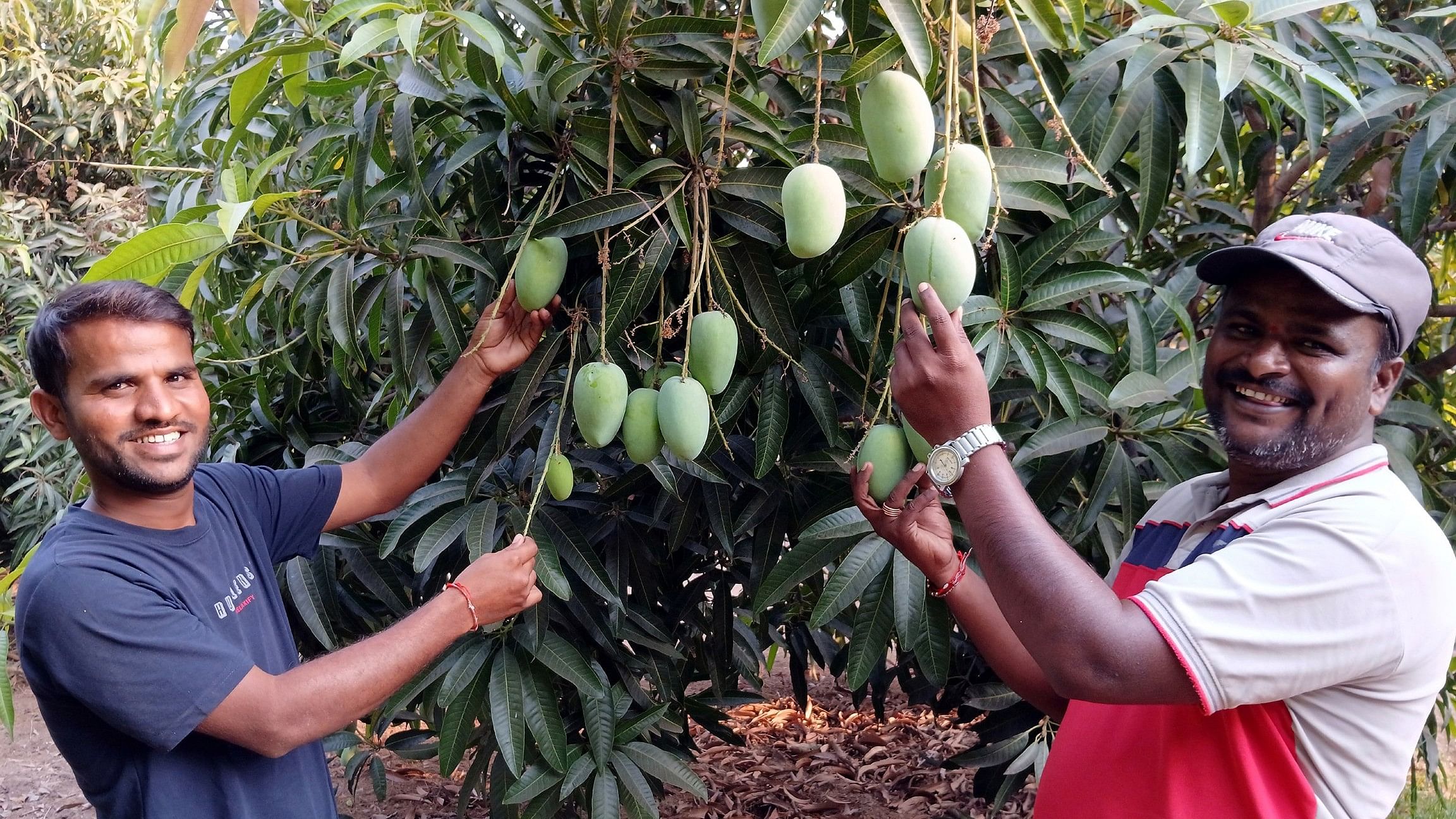
Farmers display Kesar mangoes; Consumers look at a display of the Kesar mango at a fair in Koppal recently.
Credit: Photos by author
Kesar, a popular variety of mango, is all set to make a strong mark in the state, with an increase in cultivated area in Koppal district. This variety is described as having a sweet and sour flavour. Those who like the variety say that it has a better aromatic profile than Alphonso mangoes.
The district has unique climatic conditions and soil composition that lend this flavour to the fruit. Most of Koppal mostly has red soil. Temperatures can reach 45 degrees Celsius in summer. Compared to the rest of North Karnataka, groundwater levels are good.
Mangoes are one of the main horticultural crops in this area and farmers have been growing the ‘Banganapalli’ (Benishan) variety in large areas along with Dashera and Alphonso.
When the Alphonso variety started fetching high prices, many farmers brought saplings from nurseries in Maharashtra, planting them in their fields. “Alphonso variety needs humidity. In Koppal, this level of humidity cannot be achieved and the fruits taste sour and turn spongy after ripening,” says Shrinath Thoona, an organic farmer based in Musalapur, Koppal district. Farmers are opting to grow the Kesar variety more these days, he adds.
A Kesar Mango farm near KalluTavaragere village in Koppal district.
In the last six years, the area under Kesar variety cultivation has increased from 1,300 hectares to 5,000 hectares. This year, farmers are expected to get a yield of around 40,000 tonnes.
Earlier, farmers were not aware of the popularity and the potential market for the Kesar variety. While Benishan mangoes were sold at around Rs 40 per kg, the Kesar variety was priced at Rs 10-20 per kg. Middlemen made huge profits by buying the variety at throwaway prices.
“Many farmers, including me, were giving the mangoes on lease to middlemen for the lowest price,” says Venkatesh Marathi, a farmer based in Kallu Tavaragere village. He grows the variety on three acres of land.
“We took notice of the situation and planned a strategy to provide the best value to Kesar mango. I did a survey of farmers as well as the area of Kesar mango and invited a few buyers from North India. They reached here, assessed the area, and made residue as well as taste assessments. Our Kesar mango performed better than even Gujarat mangoes, which are normally considered the best,” says Krishna Ukkunda, the deputy director of horticulture in the district. The department is currently working on creating a brand around mangoes grown in the district under the tag of ‘Koppal Kesar’.
The horticulture department has organised seminars, workshops and a ‘mango fair’ in an effort to create a platform for consumer and producer interaction. “Five years ago, we began to organise village level meetings. We assured farmers that Kesar is most suitable for the Koppal region. Farmers slowly showed interest and planted it,” says Obanna B K, assistant director of horticulture, Koppal district.
Farmer Venkatesh Marathi of KalluTavaragere village in Koppal district
From the meetings, “we realised that middlemen were making more profit and demanded a suitable price,” says Venkatesh. A fruit box weighs 2.5 kg and now mangoes are sold at around Rs 150- 250 per kg.
Early yield
In Gujarat, mango harvest starts after June, whereas in Koppal, this variety starts to ripen in March itself. Early yield helps bring more revenue for growers in the state.
Inspired by such success stories, farmers who were not growing mangoes are planting the Kesar variety. For instance, Amaresh Tatti, a farmer from Kamanur village, planted 450 saplings on four acres of land two years ago.
“The department has supplied around two lakh Kesar saplings in just three years and many farmers bought them from nurseries in Maharashtra and Andhra Pradesh also,” says Krishna Ukkunda.
Consumers seeing Kesar Mangoes in Mango Fair (Maavu Mela) organised in Koppal recently
Although the quantity and area of Kesar mango are increasing significantly, value addition efforts are yet to take off as the quantity is not sufficient for the process .
Consumers seeing Kesar Mangoes in Mango Fair (Maavu Mela) organised in Koppal recently
Officials have also arranged for financial assistance under various schemes to encourage cultivation of the variety. They now provide carton boxes and recycled paper bags at subsidised rates to farmers.
The harvest season for Koppal Kesar has begun and more than a quarter of the total produce has already been sold to buyers from other states.